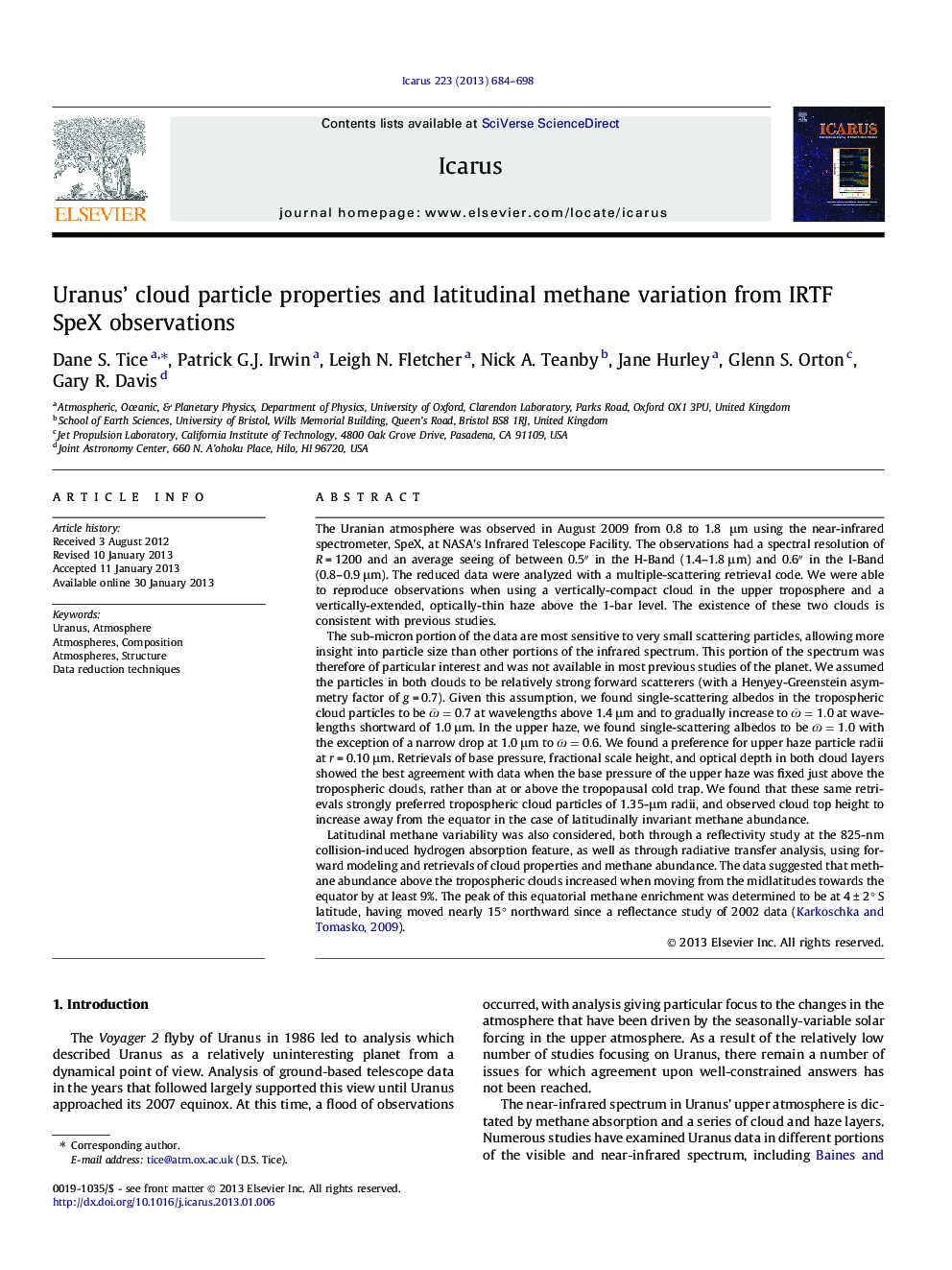| کد مقاله | کد نشریه | سال انتشار | مقاله انگلیسی | نسخه تمام متن |
|---|---|---|---|---|
| 1773348 | 1021127 | 2013 | 15 صفحه PDF | دانلود رایگان |

The Uranian atmosphere was observed in August 2009 from 0.8 to 1.8 μm using the near-infrared spectrometer, SpeX, at NASA’s Infrared Telescope Facility. The observations had a spectral resolution of R = 1200 and an average seeing of between 0.5″ in the H-Band (1.4–1.8 μm) and 0.6″ in the I-Band (0.8–0.9 μm). The reduced data were analyzed with a multiple-scattering retrieval code. We were able to reproduce observations when using a vertically-compact cloud in the upper troposphere and a vertically-extended, optically-thin haze above the 1-bar level. The existence of these two clouds is consistent with previous studies.The sub-micron portion of the data are most sensitive to very small scattering particles, allowing more insight into particle size than other portions of the infrared spectrum. This portion of the spectrum was therefore of particular interest and was not available in most previous studies of the planet. We assumed the particles in both clouds to be relatively strong forward scatterers (with a Henyey-Greenstein asymmetry factor of g = 0.7). Given this assumption, we found single-scattering albedos in the tropospheric cloud particles to be ω¯=0.7 at wavelengths above 1.4 μm and to gradually increase to ω¯=1.0 at wavelengths shortward of 1.0 μm. In the upper haze, we found single-scattering albedos to be ω¯=1.0 with the exception of a narrow drop at 1.0 μm to ω¯=0.6. We found a preference for upper haze particle radii at r = 0.10 μm. Retrievals of base pressure, fractional scale height, and optical depth in both cloud layers showed the best agreement with data when the base pressure of the upper haze was fixed just above the tropospheric clouds, rather than at or above the tropopausal cold trap. We found that these same retrievals strongly preferred tropospheric cloud particles of 1.35-μm radii, and observed cloud top height to increase away from the equator in the case of latitudinally invariant methane abundance.Latitudinal methane variability was also considered, both through a reflectivity study at the 825-nm collision-induced hydrogen absorption feature, as well as through radiative transfer analysis, using forward modeling and retrievals of cloud properties and methane abundance. The data suggested that methane abundance above the tropospheric clouds increased when moving from the midlatitudes towards the equator by at least 9%. The peak of this equatorial methane enrichment was determined to be at 4 ± 2° S latitude, having moved nearly 15° northward since a reflectance study of 2002 data (Karkoschka and Tomasko, 2009).
► Two-cloud model provides excellent fit to 2009 Uranus observations from 0.8 to 1.8 μm.
► Data range provides high sensitivity to small particle sizes and methane abundance.
► Reflectivity and radius are determined for particles in both cloud layers.
► Increase in methane abundance is verified from southern midlatitudes to the equator.
► Increase of methane abundance from northern midlatitudes to the equator is observed.
Journal: Icarus - Volume 223, Issue 2, April 2013, Pages 684–698